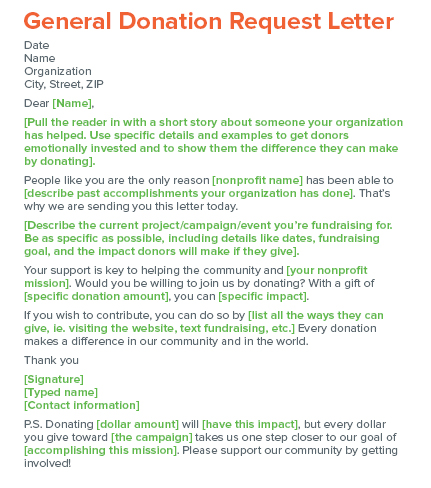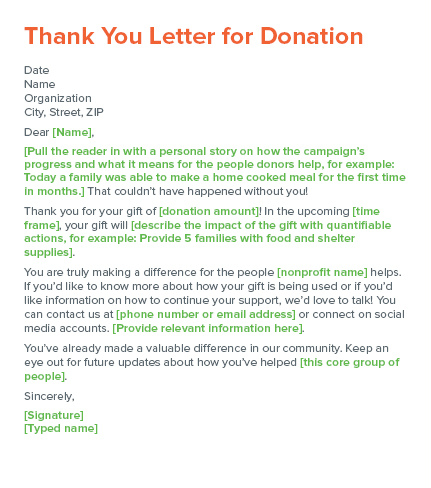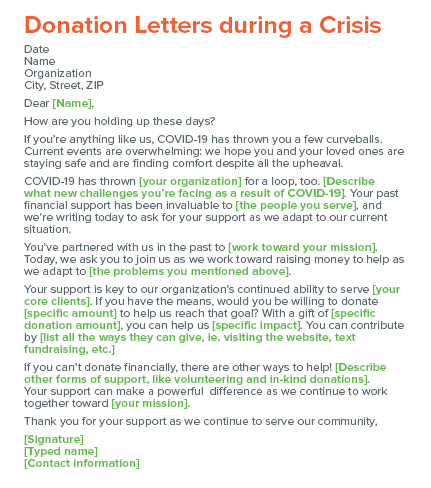
Donation letters, also referred to as donation request letters, are one of the most effective ways to reach your donors and solicit a gift. However, it’s not enough to simply send the same appeal to your entire supporter base and ask them to donate.
Writing a great donation letter is an opportunity to engage your supporters and show them the impact they have on your mission. By personalizing your donation letters, your nonprofit can not only increase your fundraising revenue but also develop relationships with your supporters.
Whether you’re just starting your donation letter strategy or seeking ways to improve it, it’s always a good idea to review the basics and make sure your communication strategies lay a solid foundation for growth.

Ready to start crafting the perfect donation letter to send to supporters?
Donation letters are used to request financial contributions or solicit in-kind donations through traditional channels, like direct mail, or using digital channels, like email. Donation request letters are an essential tool for nonprofits seeking to connect with potential donors and inspire them to contribute to their cause. These letters are particularly impactful during nonprofit giving days like GivingTuesday and targeted fundraising campaigns, providing a personal touch that can resonate with recipients.
Whether delivered through traditional direct mail or digital channels like email, donation request letters offer flexibility to suit the preferences of different donors. While they are commonly utilized to request financial contributions, it’s important to note that donation letters can also effectively solicit in-kind donations, such as goods or services, from generous supporters. This versatility allows nonprofits to leverage donation letters across various fundraising initiatives, maximizing their outreach efforts and fostering greater community engagement.
The primary goal of donation letters is to encourage your supporters to give to your cause by showing them the effectiveness of your organization’s mission. Not only can donation letters help boost your fundraising, but they can also help you establish a personal connection with your supporters to foster long-term relationships built on shared values and philanthropic impact.
A simple donation letter can also help you raise awareness for your cause. While not everyone you send a letter to may be able to give, you can provide them more information about the work your organization does so they think of you in the future.
As you’re first building out the recipient list for your donation letters, your best bet is to look at your previous donors. They’re already familiar with your organization and your work, meaning they’re more likely to give again. Plus, you can segment your previous donors by how often they engage with your organization and what campaigns they’re most likely to respond to. This allows you to create more specific donation letter templates for different types of donors and keeps you from flooding unresponsive donors’ inboxes.
Besides previous donors, donation request letters can help you motivate others to give as well. Here are some other examples of who to send a donation letter to:
Determining the right frequency for donation letters can vary based on your donors’ preferences and nonprofit’s needs. While the conventional suggestion is about four direct mail letters per year and one email monthly, it’s essential to adapt to the evolving landscape of donor engagement.
An effective strategy includes promptly surveying donors for their communication preferences post-donation or opt-in to email lists. Recording this data in your fundraising platform enables tailored correspondences in line with donors’ preferences, ensuring more meaningful engagement. Focusing not only on frequency but also on personalization and relevance is key to fostering deeper connections and driving impact for your cause.
Sending donation letters through direct mail or email remains the most common practice among fundraisers, allowing them to cater to donors’ preferences effectively. However, with the continued evolution of digital communication and the emergence of new fundraising channels, nonprofits have expanded their approaches to include various methods beyond traditional mail and email.
Here are some other ways your organization can send donation appeals to help you achieve a greater impact:
Leveraging donor data is crucial in determining the most effective communication channels for your organization. By analyzing donor behavior and preferences, nonprofits can tailor their outreach strategies to match how donors prefer to engage. For instance, if a donor has previously donated online, sending donation letters via email might be more effective, while donors who have primarily engaged offline may respond better to direct mail campaigns.
In addition, conducting donor surveys to gather insights into donors’ communication preferences is another valuable strategy. By directly asking donors about their preferred communication channels and frequency, nonprofits can refine their approach and ensure that donation letters are delivered in the most impactful way possible.
There are many different types of donation letters your organization may need to send out over the years. The most common letters are general donation appeals, thank-you letters, and sponsorship pitches. There are a lot of situations where sending a letter could help your nonprofit increase funding. Create a donation letter specific to your cause or create letters for specific events.
The contents of your donation letter should be customized to your campaign, but there are several key elements you should include:
To write an inspiring donation letter, follow these simple steps:
The first thing that your donors look for is a personalized salutation, begin your letters with a nice greeting and include your recipient’s name. Donation letters without a name seem impersonal and are more likely to be ignored. Some studies show that emails including names in the salutation are 26% more likely to be opened, but only 79% of donation emails actually use donor names! It’s also important to include your organization’s logo on the letterhead so donors recognize who the letter is from and don’t throw your letter away.
If the recipient hasn’t heard of your organization before, explain your mission at the beginning. This way, readers get a good understanding of what you’re fighting for and the goals you want to accomplish. One of the best ways to do this is by sharing a story from someone who’s benefited from your organization, and then sharing how your donors helped make a difference in that person’s life. This connects your donors to your mission and shows them the people they’ll help with a gift.
You’re likely sending out donation letters for a specific reason, whether that’s a project, campaign, or event. Describe that reason clearly and include key details like dates or guidelines. The story at the beginning of your donation letter will reinforce your appeal!
Don’t forget to explain why it’s important for your donors to support this project in your donation letters. How does it help them make a difference? Why should they give to this program in particular? For instance, if you’re raising money to provide resources to schools around the world, tell your donors the exact school and community their donations will support. Giving a backstory is a great way to connect deeper with your prospective donors.
Humans are visual creatures and often make connections to a cause through visualizing it. Include photographs of your impact, especially photos featuring people you’ve helped! If your appeal is focused more on data, use infographics that show statistics to make important information easier to understand and bright colors to attract your donors’ attention. If you’re sending your letters via email, include a behind-the-scenes video.
Donors like knowing exactly where their money is going and how it will help make a difference. Within your donation letter, make a strong ask by describing specifically what their gift will do. For example, stating that a donation of $100 provides a dog with food, shelter, and medicine helps your donors understand their impact. It may also inspire more generosity—they might decide to increase their original $50 donation to $100!
Share specific examples of how past donations have made a difference and contributed to the success of your organization’s projects or programs, if applicable. Demonstrating tangible outcomes and success stories can inspire confidence in potential donors and illustrate the impact of their contributions.
Incorporate testimonials from satisfied donors, volunteers, or community members to add credibility and authenticity to your donation request letter. Positive endorsements from individuals who have firsthand experience with your organization can resonate with potential donors and reinforce the value of supporting your cause.
It’s essential to provide a clear and direct call to action (CTA) that guides donors on how they can give. Whether it’s directing them to visit your website’s donation page, filling out and mailing back a donation form, making a text donation, or calling a designated phone number to make a contribution, clarity is key. By clearly outlining the steps donors need to take to support your cause, you remove any ambiguity and make it as easy as possible for them to act on their desire to make a difference.
Furthermore, it’s essential to create a sense of urgency and importance around your call to action, emphasizing the immediate impact that donors’ gifts will have and highlighting any deadlines or matching gift opportunities.
Express sincere gratitude to your donors for considering supporting your organization. Even if the primary purpose of your donation letter is to solicit a gift, taking the time to thank recipients for their attention and potential contribution demonstrates genuine appreciation for their support.
Additionally, ensure that your letter is signed by hand personally, ideally by a member of your organization’s leadership or a recognizable figure associated with your cause. Including contact information, such as phone numbers, email addresses, website URLs, and social media handles allows donors to easily reach out with any questions, concerns, or to make their donation. Providing this accessibility reinforces transparency and trust, essential elements in fostering strong donor relationships.
To get you started on your donation letter journey, here are some templates for common situations:

When sending donation letters, there’s a standard format you can follow or adjust to suit your unique voice and audience. Above all, your donation letters should be personalized to the recipient and effectively explain how their donation will make a difference in the world.
This template is very generic and can be referenced for any type of fundraising effort. Use this simple donation letter sample for guidance to ensure you hit the most important points, but feel free to add your own spin to it to better connect with your audience.

Every donation you receive should be answered with a heartfelt thank-you letter! After all, without the support from your donors, your organization wouldn’t be able to make the meaningful difference it has.
When crafting your thank-you donation letter, feel free to use this template to guide you. This way you know you’re keeping the content personal and effectively showing appreciation to your donor. Remember to include the impact of the gift so that your donors know it was put to good use. Include receipts for your donors’ taxes when sending thank-you letters to take care of both items in one fell swoop.

Writing donation letters during times of crisis and instability may seem like a daunting task. When approaching delicate topics like this, your best bet is to acknowledge it right off the bat and let your donors know you understand their situation. In the end, it’s important to remember that these letters should be donor-centric and focus on connecting your donor to the people they’ll help.
Follow this template to ensure you hit the important points and details. As always, you can add additional information that’s pertinent to your organization.

Donation letters and other donor communications are a great way to build important relationships and, in turn, increase your donor retention rates. To be the most effective, your communications must be personable and relevant to the recipient.
To best connect with your donation letter recipients, here are some best practices you can incorporate, in addition to the steps highlighted above:
Your donation letters have one primary purpose: to inspire your donors to give. But a great donation letter does more! By following these donation letter best practices, you lay the foundation for future engagement. Sending an engaging, inspiring donation letter gives you the opportunity to get to know your supporters better and build long-lasting relationships.
Feel free to use any of these donation letter templates to help you with your communication and fundraising needs. Having the resources to effectively reach your donors is the best way to develop relationships and increase fundraising for your organization! Donation letters help you expand your donor base and improve your connection with your current donors.
Check out these additional resources for more donation appeal templates!